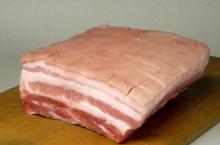Bacon, a meat product resulting from various cuts of pork, most notably from the belly, has been a major part of world cuisine for thousands of years. It's simple, tasty and high in calories, which makes it a sought-after food in times of scarcity and an indulgence in times of plenty. Bacon has seen a recent surge in popularity, becoming a sort of culinary meme and opening up cooking trends both high and low brow. It's a delightful kitchen tool and can really bring some character to traditional dishes. To get the most out of your bacon, you need to know its nuances. Here are a few things to remember about this popular type of meat.
First, it's important to understand the origins of this product. For Americans especially, this means pork belly. Pork belly is exactly what it sounds like: Meat cut from the belly of a pig. It's boneless, has moderate-to-high fat content and it packs a lot of flavor in its dense, tender space. Most of the belly bacon we eat is salt cured for preservation and flavor, with a fraction of that also being smoked for extra taste. Applewood smoked bacon is especially popular in dishes that prominently feature the meat, like sandwiches and salads.
But pork belly is valuable as more than just a source of bacon. Filets of pork belly are popping up in a lot of modern dining establishments, especially those that specialize in small plates. It's a bit too risky, health-wise, to make a whole steak out of pork belly (though it would make a heck of a last meal), but a one-inch-thick, six-inch long strip roasted and served with greens makes for a delicious main course. Similar strips do well as accompaniment to macaroni and cheese, grilled zucchini or asparagus.
In a lot of other countries, bacon doesn't come from pork belly, though. In other bacon-loving cultures like Canada and Ireland, back bacon, made from pork loin, is the preference. Back bacon is considerably leaner than belly bacon, making it ideal as a central dish rather than a side. This is often referred to as "rasher" bacon, a term indicating a discreet slice of loin. It's getting easier to find back bacon in the States these days, so feel free to experiment with it.
Using bacon in cooking is a matter of harnessing its fat content. Bacon fat is certainly higher in cholesterol than vegetable oil, but it brings a lot of flavor to the party and can actually be made fairly healthy with proper rendering. Rendering bacon is the process of coaxing the fat out of the meat for use as a frying medium. This is achieved by very slowly (i.e. on a low setting) heating the bacon in a pan with a small measure of water. Rendered bacon fat imbues dishes with a rich flavor that simply can't be achieved with oil, butter or other frying media. It's the secret ingredient in Coq au Vin, a staple of modern Asian cuisine and makes for an unparalleled Philly cheese steak sandwich.
While bacon is delicious on its own, it's worthwhile to think of it as a raw ingredient in sophisticated cooking. This means looking for fresh, local bacon just like you would look for fresh, local produce. Learn to spot the right amount of fat content for your planned dish and invest some time in learning how to cut strips at home so you can get exactly the thickness you desire. Bacon is a culinary powerhouse in the right hands and it has a lot to contribute to the world beyond the breakfast table.
